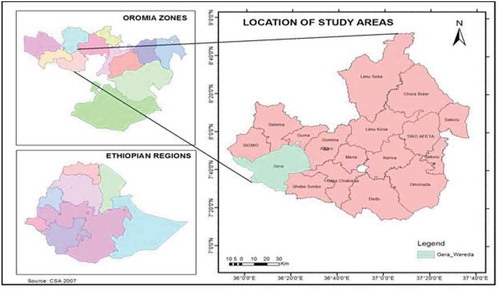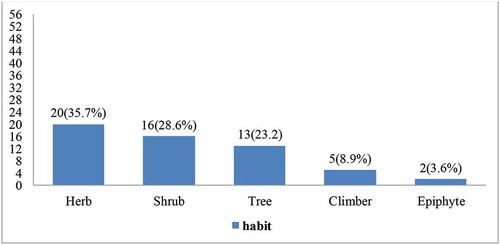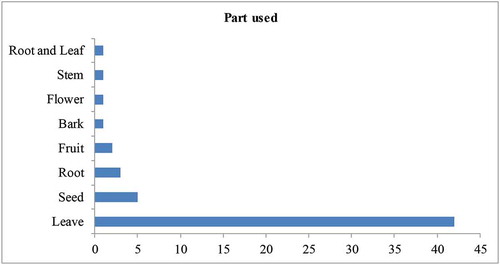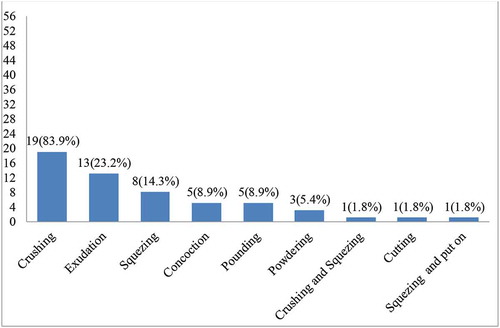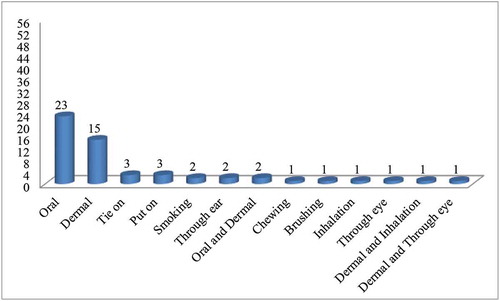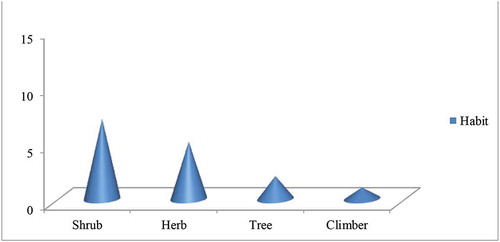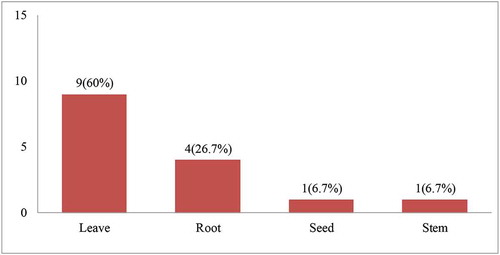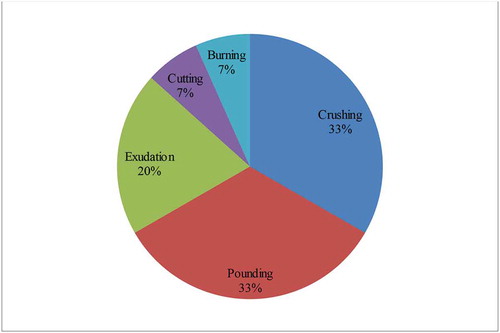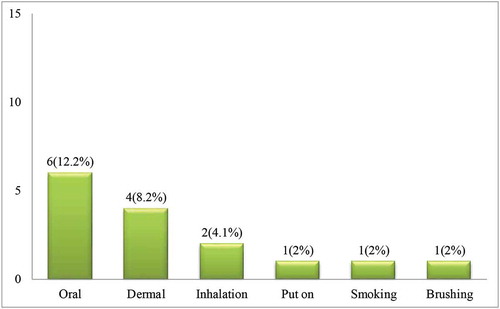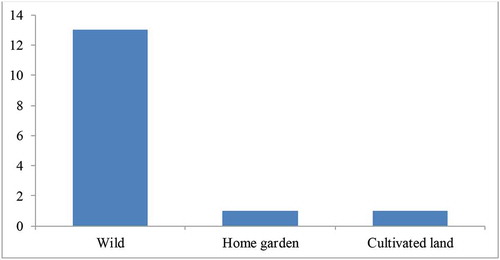Abstract
The medicinal plants have continued to be the most affordable and easily accessible source for the treatment of several human and livestock ailments in Ethiopia. The data were collected from traditional healers and knowledgeable people using group discussion, semi-structured interviews, guided field walks, and observations. A total of 63 medicinal plants, belonging to 36 families were identified. Fabaceae and Asteraceae represented by five species each (7.9%) were identified as the leading families followed by Rutaceae, Solanaceae, and Cucurbitaceae families. The majority of medicinal plants 56 (88.9%) were used to treat human ailments whereas 15 (23.8%) used to treat livestock ailments and 8 (12.7%) of medicinal plants used to treat both human and livestock ailments. Leaves were the most commonly used plant parts for remedy preparation whereas crushing was the most frequently stated herbal remedy preparation method. Notably, herbal remedies were administered orally for the treatment of ailments. Out of the total medicinal plants, 51 species (80.9%) were collected from the wild, 6 species (9.5%) were collected from the home garden, and 6 (9.5%) medicinal plants from cultivated lands. The majority of the plants for the treatment of the ailments were herbs and shrubs accounted for 35.7% and 28% respectively. The agricultural expansion was ranked as the major threat (41.6%) to medicinal plants followed by firewood (28.3%). Medicinal plants used for the treatment of ailments were intended to document the indigenous practice and serve as scientific baseline information for future pharmacological studies. Local communities could be involved in conservation and management of plant resources and their indigenous knowledge.
PUBLIC INTEREST STATEMENT
The study stated the role of the Ethnobotanical study of medicinal plants, its utilization, and conservation by indigenous people of Gera district, Ethiopia. Plants have traditionally been used as a source of medicine in Ethiopia for a long time to manage various ailments in humans and livestock. Medicinal plants are the primary remedies for the treatment of several ailments in the area. The plant-based knowledge has been transferred from one generation to the next through herbalists, knowledgeable elders, and ordinary people. Traditional healers are the primary players in the curative aspect of traditional medicine practice. Despite the role played by medicinal plants in Ethiopia, very little attempt has so far been made to document and validate the associated knowledge. Therefore, urgent ethnobotanical studies and subsequent conservation measures are required to prevent medicinal plants and the associated knowledge in Ethiopia from further loss. This study is useful for future pharmacological and phytochemical studies.
1. Introduction
Ethnobotany is defined as the study of local people’s interaction with the natural environment: how they classify, manage, and use plants available around them (Getaneh, Citation2019; Limenih et al., Citation2015). Over centuries, indigenous people have developed their locality specific knowledge on medicinal plant use, management, and conservation (Duguma & Mesele, Citation2019; Teklehaymanot, Citation2009; Yigezu et al., Citation2014). About 80% of the human population and 90% of livestock is believed to be dependent on traditional medicine and most of this comes from plants (Aragaw et al., Citation2020; Birhanu & Abera, Citation2015; Mengistu et al., Citation2019; Yigezu et al., Citation2014). About 887 plant species were utilized in traditional medicine in Ethiopia. Amongst these, 26 species are endemic and they are becoming gradually rare and are on the verge of extinction (Tefera & Kim, Citation2019; Tesema et al., Citation2002). It is believed that large concentrations of these plants are found in the southern and southwestern parts of the country following the concentration of biological and cultural diversity (Belayneh et al., Citation2012; Feyssa et al., Citation2015; Giday et al., Citation2010; Lulekal et al., Citation2008; Tamene et al., Citation2020).
Abera (Citation2014) assessed the locally available medicinal plants in the Gimbi district and found that 49 medicinal plants were used for the treatment of various diseases. Similarly, a study carried out on traditional medicinal plant knowledge and their use by local healers in the Jimma zone on 27 medicinal plants, found that the majority of the reported species grow in wild and they are rare (Feyssa et al., Citation2015; Yineger & Yewhalaw, Citation2007). Native societies have local knowledge in classifications, wherever they practice their perception and skills to classify plants. From their experience, several categorizations and classification criteria were developed which is important in plant diversity conservation and management. The common criteria here include plant use, habitat, life form, color, abundance, morphological characteristics, and combinations (Amsalu et al., Citation2018).
Sustainable use of medicinal plants has now grown to be a current issue in Ethiopia because of resource degradation in the lowland and highlands (Yeshiwas et al., Citation2019). Experience from South Africa would be essential to develop innovative methods for harvesting individual plants (Van Wyka & Prinsloo, Citation2018). There is some conservation action that has been undertaken around the world designed to protect threatened medicinal plants from further damage (Chen et al., Citation2016). This includes in-situ and ex-situ conservation measures. In-situ conservation is the conservation of species in their natural habitat. Some medicinal plants have to be conserved in-situ due to difficulty for domestication and management (Bizuayehu & Assefa, Citation2017; Doffana, Citation2017; Hamilton, Citation2004). Medicinal plants can be conserved by encouraging their growth in special places; this can be possible in places of worship. They are usually located close to the homestead; home gardens can accommodate women’s food production and household responsibilities (Chen et al., Citation2016; FAO, Citation2005; Hamilton, Citation2004).
Medicinal plants can be conserved using appropriate conservational methods in gene banks and botanical gardens (Zerabruka & Yirga, Citation2012). Conservation of medicinal plants can also be possible in the home garden, as the home garden is an intentional and perfect farming system for the conservation, production, and improvement of medicinal plants (Amsalu et al., Citation2018; Usmane et al., Citation2016). For poor rural people, medicinal plants represent affordable and locally available resources to address many diseases and health problems. Besides, the damage to valuable medicinal plants due to population pressure, agricultural expansion, and deforestation is extensively reported by the different researchers (Alemayehu et al., Citation2015; Kebede et al., Citation2017; Yirga, Citation2010).
As a result, the need to conduct ethnobotanical investigation and to document the medicinal plants and the associated indigenous knowledge is an urgent task (Amsalu et al., Citation2018; Bizuayehu et al., Citation2019; Meragiaw et al., Citation2016). There was no study done on medicinal plant utilization and conservation in study area. Therefore, the study was aimed to identify the medicinal plants, rate of utilization, and the conservation mechanisms in the study area.
2. Material and methods
2.1. Description of the study area
The study was conducted in the Gera district, Jimma zone, Oromia National Regional State. It is located at 97 km from Jimma town, zonal capital and 445 km from Addis Ababa, capital of country. The district has three agro-climatic zones, that climatic feature is explained as 50.2% (highland), 46% (mid-altitude), and 3.7% (lowland). The altitude of the study area is between 1,500 and 2,200 meters above sea level. Rainfall is often in between 1,880 and 2,080 millimeter per annual. The study area lies in the moist evergreen montane forest in southwestern Ethiopia and the area contains different shrubs, herbs, and trees. However, there are very fast encroachments of the forest area due to high population pressure. Soil and water conservation structures have not been built to arrest soil erosion. There is also a natural forest, which is planted in coffee and shared among individual farmers. Many of the farmers in the area depend on coffee for their livelihood (Solomon et al., Citation2014). Gera district has a total population of 147,120. Livestock production is the second most agricultural activity of the people next to crop cultivation and the total livestock population in this district has 263, 629 cattle, 97, 571 Sheep, 22,466 Goats, 44,333 horses, 9372 mules, 2574 donkeys, and 151,814 poultry ().
2.2. Materials required
Plant specimens were collected using collecting, pressing, and drying equipment for the field, such as collecting bags, cutting tool scissors, permanent markers, field notebooks, pre-printed collection formats such as printed checklists of semi-structured questions for the interview, plant diggers, photographic camera, GPS, and topographic maps. In addition to that, specimen pressing and drying equipment with wooden frames, straps, cardboards, blotters, newspapers, plasters, ethanol alcohol (70%), and plastic bags that have various sizes for storage of plant parts.
2.3. Methods of data collection
2.3.1. Reconnaissance survey
A reconnaissance survey was conducted from January 5–20; 2016 in the study area. The study sites were purposively selected based on the recommendation from elders, local authorities, and those knowledgeable persons. Out of 31 peasant associations the study was carried out in six peasant associations ().
Table 1. Study sites with their respective location
2.3.2. Sampling of informants
A total of 60 individuals with the age of 30 years and above were selected from six peasant associations purposively based on the intensive knowledge of medicinal plants they have. The informants were selected from the local people of the study area to see the general knowledge of medicinal plants depend on their willingness to participate. The selection of informants was following the methods described by Martin (Citation1995), who indicated that when recording indigenous knowledge controlled by Ethnobotanical healers or by certain social groups the selection of key informants is important. From the total of informants, 10 key informants (9 males and 1 female) were selected based on the recommendation from elders and local authorities. Local healers were also considered as key informants since they are expected to have intensive knowledge of medicinal plants.
2.3.3. Data collection
Ethnobotanical data were collected from January to May 2017 on the way of utilization and conservation of medicinal plants by the people of Gera district according to methods described by Martin (Citation1995) and Cotton (Citation1996) who indicated that when recording indigenous knowledge controlled by Ethnobotanical healers or by certain social groups the selection of key informant is vital. The key informants share their knowledge on the method of preparation and mode of application of different medicinal plants that are used to treat both human and livestock ailments. Moreover, the medicinal plants that have other uses (multipurpose) than medicinal activity were recorded.
2.3.4. Semi-structured interviews and group discussion
Semi-structured interviews were conducted with 60 informants in the local language to collect ethnobotanical data. The collected data include informants’ names, sex, age, address, common human and livestock ailments in the area, conservation methods, preparation methods, and route of administration, threats of medicinal plants, and other uses of medicinal plants. A brief group discussion was made with informants at each peasant association before ethnobotanical data collection. During the discussions, an attempt was made to let them understand that their knowledge and the continued practice of their art of traditional medicine have not interfered with the researcher.
2.3.5. Specimen collection and identification
At the end of each interview, sample specimens of the plants cited for their medicinal use were collected, numbered, pressed, and dried for identification. The local names and growth habits of the medicinal plants were recorded for each plant species. Preliminary identification was done in the field. The voucher specimens which could not be identified in the field have been taken to Jimma University Herbarium and identified by using taxonomic keys, the flora of Ethiopia, and Eritrea.
2.4. Data analysis
2.4.1. Descriptive statistics
The collected data were recorded, coded, and stored using Microsoft® Excel for Windows 2007. The collected ethnobotanical data was analyzed using Statistical Package for Social Sciences software version 20 (SPSS software V.20). Thereafter, the most useful information gathered on medicinal use, plant habit, habitat, methods of preparation, and route of administration of medicinal plants was analyzed by using descriptive statistics.
2.4.2. Preference ranking
It was conducted following Martin (Citation1995), for five important medicinal plants used to treat human and livestock disease Stomachache. Five randomly selected informants were participated in this method to identify the best preferred medicinal plants for the treatment of Stomachache. The informants were given the plants and asked to arrange the medicinal plants based on their efficacy by assigning the highest value (5) for plant species most preferred and the lowest value (1) for the least preferred plant and value in between for the remaining. Then, the results were summarized for all respondents and ranked based on the total scores obtained for each medicinal plant.
2.4.3. Direct matrix ranking
The numbers of multipurpose species were selected from the total medicinal plants and use diversities of these plants were listed for four randomly selected key informants to assign use value to each species. Each selected key informant was asked to assign use-value (5 = best, 4 = very good, 3 = good, 2 = less used, 1 = least used and 0 = not used). The average score of each species was summed up and ranked.
2.4.4. Paired comparison
Ten key informants were selected and asked to choose the best six medicinal plants from every pair according to personal opinion in treating a wound. The total number of possible pairs were obtained by applying the formula n (n-1)/2, where n is the number of medicinal plants being compared. A total rank of paired comparison was obtained by summing the number of times each plant was chosen. An item with the highest frequency of choices had the highest score.
2.4.5. Informant consensus
During the study, each informant was visited 2–3 times to confirm the reliability of the ethnobotanical information. Consequently, the responses of an informant that were not in agreement with each other were rejected since such responses were considered as unreliable.
2.4.6. Informants consensus factor (ICF)
Informants consensus factor (ICF) was calculated for each category to identify the agreements of the informants on reported cures for the group of ailments. The ICF was calculated as follows (Heinrich et al., Citation1998). ICF = nur-nt/nur-1, where ICf = Informants consensus factor, nur = number of use citation in each category, nt = number of species used.
3. Results
3.1. Local beliefs on medicinal plants
The local people exploit their shared knowledge to manage health problems at home by using different plants found around them, before looking for other options regardless of the type of health problem and its intensity. According to the respondents of the study area, their preference for traditional medicine was due to lack of substituents for some of the diseases in modern health-care services. For instance, diseases believed to be caused by the urine of bat, not only easy to accessibly but also low cost for treatment by traditional medicine.
3.2. Medicinal plants in the study area
A total of 63 medicinal plant species were collected and identified for treating 50 humans and 18 livestock ailments. Of the 63 medicinal plant species, 56 (88.9%) used by local people to treat various human ailments, 15 (23.8%) used to treat livestock ailment and 8 (12.7%) medicinal plants used to treat both human and livestock ailments. Out of the total medicinal plants, 51 (80.9%), 6 (9.5%), and 6 (9.5%) of medicinal plant species were collected from the wild, home garden, and cultivated lands, respectively. Fabaceae and Asteraceae were the leading families each represented by five species (7.9%) followed by Rutaceae, Solanaceae, and Cucurbitaceae which represented by four species (6.34%). Lamiaceae, Malvaceae, Euphorbiaceae, and Rosaceae were represented by three species (4.76%) each whereas Rubiaceae, Acanthaceae, and Orchidaceae were represented by two species (3.17%) each. The rest 23 families were represented by one species (1.58%) each ().
Table 2. List of medicinal plants of the study area
3.3. Medicinal plants used to treat human ailments
Medicinal plants were the primary remedies for the treatment of several ailments in the Gera district. A total of 56 plant species were identified by the local community used for the treatment of 50 human ailments. Asteraceae contributed five species (8.9%), Rutaceae and Fabaceae accounted four species (7.1%), Lamiaceae, Malvaceae, Euphorbiaceae, Solanaceae, Rosaceae, and Cucurbitaceae accounted three species each (5.35%), Rubiaceae, Acanthaceae, and Orchidaceae accounted two species each (3.57%) and the remaining families contributed one species (1.78%) each were medicinal plants used to treat human ailments. Of the medicinally important plant species that are used to treat human ailments recorded in six peasant associations of Gera district, 41 (73.2%), 4 (7.1%), and 11 (19.6%) species were collected from the wild, home garden, and cultivated land, respectively ().
3.3.1. The growth form of medicinal plants used to treat human ailments
The medicinal plant species used to treat the human ailment in study areas were categorized as herbs (35.7%), shrubs (28.6%), trees (23.2%), climbers (8.9%), and epiphyte (3.6%) as presented in .
3.3.2. Medicinal plant parts used to treat human ailments
The informants of the study area reported that leaves (75%) were the dominant plant part or remedy preparation, followed by seeds (8.9%), roots (5.4%), and fruit (3.6%). However, some of them reported that bark, root, and leaf, flower, and stem which represented by 1.8% each were plant parts used to prepared remedies in the area ().
3.3.3. Method of preparation and route of administration of medicinal plants used to treat human ailments
For human ailments, the local community was employed in various methods for the preparation of plant remedies for different types of ailments. The principal methods of plant remedy preparation were crushing (33.9%), followed by exudation (23.2%), squeezing (14.3%), concoction (8.9%), and pounding (8.9%). The remaining (1.8%) were prepared through mixed of crushing and squeezing and put on, cutting, squeezing, and pounding ().
3.3.4. Mode of application of medicinal plant used to treat human ailments
Medicinal plants are applied through different routes of administration. In the study area oral (41.1%) was the dominant route of administration, followed by dermal (26.8%), tie on (5.4%) and put on (5.4%), smoking (3.6%), through the ear and oral, and dermal together accounted 3.6% each. The remaining (1.8%) applied types were chewing, brushing, inhalation, through the eye, dermal, and inhalation together and dermal, and through the eye ().
3.4. Medicinal plants used to treat livestock ailments
In comparison to human disease, livestock diseases are treated with a few numbers of plant species. Euphorbiaceae was the dominated medicinal plant families represented by three species (20%) and followed by Cucurbitaceae (13.3%) and Solanaceae, Asteraceae, Alliaceae, Fabaceae, Phytolacaceae, Acanthaceae, Amaryllidaceae, and Meliaceae represented by one species (6.6%) each.
3.4.1. The growth form of medicinal plants used to treat livestock ailments
Out of the 15 medicinal plant species used to treat livestock ailments in the study area are shrubs (8 species, 53.3%) were the dominant growth form followed by herbs (four species, 26.6%), climber (one species, 6.6%), and trees (two species, 13.3%) as described in .
3.4.2. Medicinal plant parts used to treat livestock ailments
Regarding the plant parts which are used to treat livestock ailments leaves were widely used for a range of preparation than the other parts. Leaves accounted for nine species (60%), followed by roots that accounted for four species (26.6%), and stem and seed accounted for one species (6.6%) each ().
3.4.3. Methods of preparation of medicinal plant used to treat livestock ailments
The major preparation method of livestock medicine was crushing and pounding, accounted for five medicines (10.2%) each, followed by exudation which accounted for three species (20%), cutting and burning accounted for one species (6.6%) each ().
3.4.4. Mode of application of medicinal plant used to treat livestock ailments
The mode of applications was oral, dermal, put on, inhalation, and brushing, which were adopted for a total of 15 preparations in the treatment of livestock ailments. Out of 15 preparations, 40% were administered orally followed by dermal (26.6%), inhalation (13.3%), and smoking, put on, and brushing (6.6%) each ().
3.4.5. Habitat of medicinal plants used to treat livestock ailments
Out of 15 medicinal plants collected to treat livestock ailments 13 species (86.7%) were collected from the wild and the rest medicinal plants were collected from the home garden and cultivated land 1 species (6.7%) each ().
3.5. Importance of different medicinal plants used by the local people
The degree of importance of medicinal plants was checked by conducting various methods including preference ranking, direct matrix ranking, and paired comparison.
3.5.1. Preference ranking
When there are different species prescribed for the same health problem, people show a preference for one over the other. Tarderemotum Bitter stood raked first hence, it is the most effective medicinal plant to treatment stomachache, followed by Vernonia amygdalina, Ruta chalepensis, Croton macrostachyus, and Ocimum urticifolium ().
Table 3. Preference ranking of medicinal plants used for treating stomachache
3.5.2. Direct matrix ranking
The majority of the community in the study area relied on wild plants for various purposes such as charcoal, construction, fencing, firewood, furniture making, and medicinal. To assess the relative importance and to check the major impact on such plants direct matrix ranking was performed. The direct matrix showed that Croton macrostachyus was the most multipurpose medicinal plant followed by Eucalyptus globules, Prunus africana, Euphorbia abyssinica Gmel, Albizia gummifera, and Vernonia amygdalina ().
Table 4. Direct matrix ranking of six plant species by four informants based on six use categories (5 = best; 4 = Very good; 3 = good; 2 = less used; 1 = least used and 0 = no value)
3.5.3. Paired comparison
For the medicinal plants that were identified by the informants to treat wounds, a paired comparison was made among six of them using 10 informants to know their rank. The results that were obtained from informants were summed up and compared plants were abbreviated in the table. Accordingly, Senecio schimperi, Bip.ex A. Rich was selected 10 times and stood first indicating that it is the most effective in treating wound followed by Rumex napalensis Spreng, Acmella caulirhiza Del, Croton macrostachyus A. Rich, Vernoni rueppelli Sch.Bip.ex Walp, and Kosteletzekya adoensis (Hochst.ex A.Rich) Mast ().
Table 5. Paired comparisons of medicinal plants used to treat the wound
3.6. Informant consensus
This result showed that Ruta chalepensis was ranked first (65%) informants for its medicinal value for treating cough, stomachache, and fibril illness. Croton macrstachyus and Ocimum lamifolium were ranked second (61.9%) each, followed by Zingiber officinale ranking third (60.3%) as described in .
Table 6. List of medicinal plants and the corresponding informants
3.7. Informant consensus factor (ICF)
The highest informant consensus factor (0.9) value was recorded for disease related to fibril illness, diarrhea, snake poison, fungus, and malaria while the least factor (0.3) was noted for evil eye, eye problem, rabies, kidney, colic, and amoeba, ectoparasite, and bloating ().
Table 7. Informant consensus factor by categories of disease in the study area
3.8. Threat and conservation of medicinal plants in the study area
3.8.1. Threats of medicinal plants
The cause of threats to medicinal plants can be generally grouped into natural and human factors. However, as reported in this study most of the causes for the threats to medicinal plants and associated knowledge were the anthropogenic factors such as deforestation due to over-exploitation of plants for different uses/charcoal, firewood, construction, overgrazing, cutting, and burning of plants to create new agricultural lands, medicinal plants trade for different uses and others. The major factor for plant destruction was agricultural expansion (41.6%), followed by firewood (28.3%), charcoal production (16.6%), and construction (13.3%) as presented in . This forced the people to go far away from their homes to collect medicinal plants and some informants claimed that the scarcity of medicinal plants in their area was one of the factors that forced them to visit expensive health institutions. Moreover, informants reported that the young generation refused to know or inherit knowledge and use traditional medicine. As a result, a lot of valuable information could be lost whenever traditional medicinal practitioners die without sharing their knowledge with others.
Table 8. Major threats on Medicinal Plants of the study area
3.8.2. Conservation of medicinal plants
Key informants responded that as the population increases, the utilization of medicinal plants for different purposes like firewood, construction, and equipment which linked with the daily activities of the community. Indigenous people in the study area have a strong belief in the healing power of plants and they know their habitat, harvesting technique, and time of harvest. In the study area, there were only six medicinal plants found in the home garden. This indicated that there were little attempts of cultivating medicinal plants at their home garden due to easy access to wild medicinal plants in the past and some medicinal plants are difficult to domesticate. However, the elders and practitioners know the importance of conserving medicinal plants and believed that home gardens are good places for the conservation of medicinal plants as well as for the better transfer of indigenous knowledge to the younger generation. Some practitioners have started to conserve medicinal plants by cultivating in their home garden. For instance, medicinal plants like Pentas lanceolata, Hagenia abyssinica (Bruce) J.F.Gmel, Brucea antidysenterica J.F.Mill, and Ruta chalepensis were found in some household gardens and farm borders in the study area, as they need these plants in their daily life as medicine.
4. Discussion
4.1. Medicinal plants in the study area
In the present study, a total of 63 medicinal plants and their uses by local people were documented. This indicates the depth of the local indigenous knowledge on medicinal plants and their applications. Out of the collected medicinal plants, 56 (88.9%) species were used to treat human diseases, and 15 species (23.8%) were used to treat livestock ailments. About 8 (12.7%) species of medicinal plants were used to treat both human and livestock ailments. They use more medicinal plants to treat human diseases than livestock ailments. This may be due to local people in the area seek traditional medicine for their ailments first and then try to search for their livestock ailments. Similar to this findings, Kassa et al. (Citation2020) reported that most of the medicinal plant in Sheka zone used to treat human ailments (77%) and 19% of medicinal plant was used treat both human and livestock ailments. Most of the medicinal plant species collected and identified in this study were also found to be used in other parts of the country which is in line with the present result (Amsalu et al., Citation2018; Gebeyehu et al., Citation2014; Kelayu et al., Citation2013; Lulekal et al., Citation2008; Megersa et al., Citation2013). These findings indicated that the local people over a wide area in Ethiopia show the tendency to use the same medicinal plants and this can be an indicator of the genuine therapeutic value of these medicinal plants as well as the indigenous knowledge on medicinal plants and to a certain extent their efficacy.
Regarding the families of medicinal plants, Asteraceae and Fabaceae were represented by the highest number of species (5 species 7.9% each). This was followed by Rutaceae, Solanaceae, and Cucurbitaceae which was represented by four species (6.3%) each. Families of Lamiaceae, Malvaceae, Euphorbiaceae, and Rosaceae represented by three species (4.7%) each, whereas Rubiaceae, Acanthaceae, and Orchidaceae represented by two species (3.1%), and the rest 23 families were represented by one species (1.6%) each. This finding shows that family Asteraceae and Fabaceae contributed the highest number of medicinal plant species when compared to other families. Comparable to this finding several studies in Ethiopia (Abera, Citation2014; Amsalu et al., Citation2018; L. Kidane et al., Citation2018; Lulekal et al., Citation2008; Mesfin et al., Citation2009; Tefera & Kim, Citation2019) have reported Fabaceae as a dominant family with 5–26 medicinal plant species. Similar to this result another study in Ethiopia also noted that Asteraceae was the dominant family with 5–15 medicinal plant species among others (Bahadura et al., Citation2020; Chekole et al., Citation2015; Getaneh & Girma, Citation2014; Meragiaw et al., Citation2016). The dominancy of the Asteraceae family may be due to it contains a wide range of biologically active compounds and the largest families in the plant kingdom (Chijindu et al., Citation2020; Gazzaneo et al., Citation2005; Simbo, Citation2010). In contrast, other studies found that Lamiaceae (Tesfaye et al., Citation2009) and Euphorbiaceae (Jima & Megersa, Citation2018; Tamiru & Asalfew, Citation2016) were dominant over others.
4.2. Medicinal plants used to treat human ailments
Medicinal plants were the primary remedies for the treatment of several ailments in the Gera district. A total of 63 plant species were identified by the local community used for the treatment of 50 human ailments. From a total of 63 of ethnomedicinally important plant species that are used to treat human ailments recorded in the study area, 41 (73.2%) are collected from the wild followed by 11 (19.6%) and 4 (7.1%) are from cultivated land and home garden, respectively. This indicated that people of the Gera district highly depend on wild sources to obtain the medicinal plants. Besides, the habit of cultivating the medicinal plant in the home garden was not much developed. This result agrees with a various reports from Ethiopia and other countries (Abera, Citation2014; Amsalu et al., Citation2018; Andarge et al., Citation2015; Chekole et al., Citation2015; Hu et al., Citation2020; L. Kidane et al., Citation2018; Teklay et al., Citation2013), which reported 42.6%–81.6% of medicinal plant species were collected from natural vegetation.
4.2.1. Growth form of medicinal plants used to treat human ailments
This study revealed that medicinal plants used to treat human ailments constitute of herbs 20 (35.7%), shrubs 16 (28.6%), trees 13 (23.2), climbers 5 (8.9%), and epiphyte 2(3.6%). This may be herbs were largest in number, exhibit high level of abundance, and easy to assess them. In agreement with this Baydoun et al. (Citation2015) and Bahadura et al. (Citation2020) reported that herbs were dominancy in the preparation and serving of primary healthcare and therapeutic indication due to their medicinal properties. Similar findings were also reported previously in Ethiopia and other countries indicated that 39.9%-56.6% of medicinal plants were constituted of herbs (Amsalu et al., Citation2018; Ali et al., Citation2020; Chekole et al., Citation2015; Hailemariam et al., Citation2009; Hu et al., Citation2020; L. Kidane et al., Citation2018; Teklay et al., Citation2013). However, a study conducted in Mana Angetu and Sekoru district reported that shrubs (47.83%) were dominant growth forms of medicinal plants (Lulekal et al., Citation2008; Yineger & Yewhalaw, Citation2007). This variation in growth forms of the medicinal plant may be associated with a difference in seasonality, socio-cultured belief, and practice of the healers of different regions and countries.
4.2.2. Medicinal plant parts used to treat human ailments
People of the study area harvest different plant parts for the preparation of traditional drugs (e.g., leaves, roots, seeds, barks, and fruits). In the study area, 42 species (75%) were harvested for their leaves. This is because leaves were relative ease of finding; harvesting leaves have less impact on the plant than other parts and simplicity of preparation. Scientifically, leaves are the most active part of the plant in terms of the production of metabolites (Baydoun et al., Citation2015; Ghorbani, Citation2005). This finding agrees with various studies conducted in Ethiopia (Amsalu et al., Citation2018; Kassa et al., Citation2020; L. Kidane et al., Citation2018; Meragiaw et al., Citation2016; Tefera & Kim, Citation2019; Zerabruka & Yirga, Citation2012) reported leaves (32.6%-56% medicinal plants) as the most widely used plant parts.
4.2.3. Method of preparation and route of administration of medicinal plants used to treat human ailments
The local community employed various methods of preparation of traditional medicines for different types of ailments. Crushing, exudation, squeezing, pounding, concoction, put on, and cutting were some of the preparation methods used to treat human disease in the study area. The principal methods of plant parts remedy preparation form were crushing (33.9%) followed by exudation (23.2%) and squeezing (14.3%). Yineger and Yewhalaw (Citation2007), Teklay et al. (Citation2013), and Amsalu et al. (Citation2018) reported the popular method of remedy preparation was crushing with 37.3%, 34%, and 54.5%, respectively. However, Mohammed and Seyoum (Citation2013) in Chencha district reported that concoction was a dominant method of preparation of remedy, and Kelayu et al. (Citation2013) documented that the people of Gemad district prepared their remedies mostly by grinding. Some routes of administration were oral, dermal, smoking, chewing, brushing, inhalation, ocular, and externally. In the study area, oral (41.1%) is the dominant route of administration followed by the dermal (26.8%) route. This result in line with various studies in Ethiopia and other countries (Amsalu et al., Citation2018; Belayneh et al., Citation2012; Chekole et al., Citation2015; Hu et al., Citation2020; Kelayu et al., Citation2013; L. Kidane et al., Citation2018; Meragiaw et al., Citation2016; Mersha et al., Citation2016; Tefera & Kim, Citation2019; Zerabruka & Yirga, Citation2012) they reported that the major way of medicinal plants administration was the oral route with 42.5–74 percentage. Internal ailments were commonly treated by making the patient drink herbal preparation; tooth infections were treated by crushing and apply on the remedial plant.
4.3. Medicinal plants used to treat livestock health problems
In comparison to human disease, livestock disease is treated with less number of plant species. In the study area, 15 plant species were collected to treat livestock ailments. They were grouped into 15 genera and 12 families. The families of medicinal plants used in livestock health problems, family Euphorbiaceae represented by three species (20%) and it was the leading family. Similar to this finding, a study conducted in various parts of Ethiopia indicated that Euphorbiaceae accounted with four species was the most important family of medicinal plants used to treat various livestock ailments (Feyera et al., Citation2017; Mekuanent et al., Citation2015; Romha et al., Citation2015). About 86.6% of plants were obtained from the wild and this shows that the attempt of the local community is not promising for cultivating livestock remedies in the home garden. Several studies in Ethiopia show that the majority of medicinal plants with 54.4%-94.6% were harvested from the wild (Jima, Citation2018; Mohammed et al., Citation2016; Usmane et al., Citation2016; Yigezu et al., Citation2014; Yineger et al., Citation2008).
4.3.1. Growth form and part of medicinal plants used to treat livestock ailments
Out of the 15 plant species used for treating livestock ailments in the area, 14.3% of species were shrubs. A study conducted by Mesfin et al. (Citation2009) and Tilahun et al. (Citation2019) indicated that the shrubs were identified as a major plant habit harvested for livestock disease treatment with 40% and mean of 32.05, respectively. However, the findings of Teklehaymanot and Giday (Citation2007) showed that herbs (52%) were the most frequently used plant habit. The plant parts documented for various medicines to livestock ailments, leaves accounted the highest represented by nine species (18.4%) followed by roots, four species (8.2%). It has been noted that the collection of leaves alone could not pose a lasting danger to the continuity of an individual plant compared with the collection of roots, bark, stem, and whole plant. The finding of Hailemariam et al. (Citation2009), Yigezu et al. (Citation2014), Usmane et al. (Citation2016), Mohammed et al. (Citation2016), and Feyera et al. (Citation2017) in Ethiopia, and Kamatchi and Parvathi (Citation2020) and Traore et al. (Citation2020) in other countries revealed that leaves (37%–68.1%) were the most used parts of medicinal plants followed by roots. Moreover, Adefa and Abraha (Citation2011) indicated that 48% of medicinal plants used to treat livestock remedies were prepared from leaves in Tehuledere district, South Wollo, Ethiopia. However, and Birhan et al. (Citation2018) showed that roots were the major plant part used to treat livestock ailments with 42.1% and 34.4%, respectively.
4.3.2. Method of preparation and mode of application of medicinal plants used to treat livestock ailments
The preparation method of livestock medicinal plants includes various techniques such as crushing, exudation, pounding, cutting, and burning. The majority of the method was contributed by crushing and pounding which accounted for five medicinal plants (10.2%) each followed by exudation accounted for 3 medicinal plants (6.1%). This finding was in line with the report of Hunde et al. (Citation2006). The routes of application like oral, dermal, put on; smoking, inhalation, and brushing have been documented in associated with various ailments. The commonly adopted route of the application was oral which accounted for 6(12.2%) preparations followed by 4 (8.2%) preparation through dermal. Studies conducted by Amenu (Citation2007) from the Chelya district and Lulekal et al. (Citation2008) from Mana Angetu district were showed that oral routes of administration were more prominent represented by 60.5% and 50.5%, respectively, which agrees with this finding. This study also agrees with studies conducted by Yigezu et al. (Citation2014), Usmane et al. (Citation2016), Mohammed et al. (Citation2016), and Traore et al. (Citation2020) who reported that the highest root of administration was oral which accounted 76.2%, 65.3% 70%, and 76%, respectively.
4.4. Ranking of medicinal plants
This result indicated that medicinal plants were preferred by local people than others. This showed that local people acquire knowledge through experience and could differentiate medicinal plants that are effective for the treatment of their ailment or their livestock ailments. Among the medicinal plants used to treat stomachache, Solanum tarderemotum stood first and hence is the most effective medicinal plant to cure stomachache, followed by Vernonia. In the study area, several medicinal plants were found to be multipurpose species being utilized for a variety of uses. According to the direct matrix ranking result, Croton macrostachyus ranked first as the most preferred medicinal plants used for various purposes by local people. In line with the present result, Amsalu et al. (Citation2018) and, Tefera and Kim (Citation2019) reported the Croton macrostachyus as the highest multipurpose medicinal plant used in Farta and Hawassa zuria districts, respectively, in Ethiopia. However, Croton macrostachyus is the most preferred medicinal plant for various users in the Wayu Tuka district in Ethiopia (Kassa et al., Citation2020; Megersa et al., Citation2013).
The most frequent disease categories treated with medicinal plants and showing the highest citations were those concerning febrile illness, diarrhea, snake poison, fungus, malaria, stomachache, and wound. This is in agreement with the reports of L. Kidane et al. (Citation2018) and Kassa et al. (Citation2020) who have reported febrile illness, diarrhea, cough, snake poison, and malaria to be treated by several medicinal plants. Eucalyptus globules are the most frequently medicinal plant used to treat cough, common cold, influence whereas Ruta chalepensis is used to treat stomachache, abdominal pain, diarrhea, and amoeba. Similarly, Ocimun urticifolium is used to treat colic, stomachache, tapeworm, diarrhea, cough, eye infection, and febrile illness. Nicotina tobacum is the most frequently used plant for pasteurellosis, bloating, and endoparasites in livestock which agrees with a study carried out in southwest Ethiopia (Bogale et al., Citation2017; Yigezu et al., Citation2014). Echinops kebericho is used to treat snake poison and pneumonia which is in agreement with the finding of Tulu et al. (Citation2018), who reported that Echinops kebericho used to treat pneumonia and snake poison.
4.5. Threat and conservation of medicinal plants in the study area
4.5.1. Threats of medicinal plants
The indigenous people in the study reported medicinal plants were threatened by agricultural expansion, charcoal production, firewood, and over-harvesting (Alemayehu et al., Citation2015; Mekuanent et al., Citation2015). The major threat to medicinal plants in the study area was agricultural expansion (41.6%), charcoal production (16.6%), firewood (28.3%), and construction (13.3%). In agreement with this finding, Yineger and Yewhalaw (Citation2007), Lulekal et al. (Citation2008), L. Kidane et al. (Citation2018), Jima (Citation2018), Jima and Megersa (Citation2018), and Tamene et al. (Citation2020) had also reported that deforestation (28%-90%) and agricultural expansion (34%–55%) as the main factor for disappeared of medicinal plants in different parts of the country. Agriculture expansion and lack of culture traditional medicinal plants were major threats in southern Ethiopia which is in agreement with the current finding (B. Kidane et al., Citation2014). Similar to this result, Giday et al. (Citation2003) and Balemie et al. (Citation2004) indicated that medicinal plants have been affected by a dramatic decrease in the area of native vegetation due to agricultural expansion, deforestation, fire, overgrazing, and charcoal.
4.5.2. Conservation practice of medicinal plants
The influences of humans on the natural habitat of medicinal plants are the problems for the conservation of medicinal plants and associated knowledge. Some informants have started to conserve medicinal plants by cultivating at home gardens. About 20.6% of the medicinal plants collected were reported as found at cultivated land (cropland) and about 9.1% of medicinal plants were reported as cultivated at home gardens and these include plants like Carica papaya and Ocimum lamifolium. The same information was document by Usmane et al. (Citation2016) Amsalu et al. (Citation2018). Similarly, Lulekal et al. (Citation2008) and Jima and Megersa (Citation2018) indicated that only 5.7%-13.8% of medicinal plants were cultivated in the home garden in Mena Angetu and Gozamin districts shown that minimal effort of medicinal plant conservation.
5. Conclusion
A study on medicinal plant utilization in the Gera district revealed that the community commonly uses medicinal plants for maintaining their primary healthcare and livestock. This study has shown that herbal medicine continues to be of great importance to this community in Ethiopia as part of their healthcare system, knowledge continues to be passed on via the oral tradition and by application. The community was motivated to help to increase awareness of, and accessibility to, the herbs they use to treat illness in the family home. The study has resulted in the collection and identification of 63 medicinal plant species where Asteraceae and Fabaceae were leading families with the highest proportion. Most of (63) medicinal plants were harvested from the wild and some of (6) them were from home gardens and cultivated lands. Out of the 63 medicinal plants documented in the study area 56 medicinal plants were used to treat human ailments and 15 medicinal plants are used to treat livestock ailments. Herbs were the dominant growth form of medicinal plants used to treat human ailments whereas shrubs were the dominant growth form of medicinal plants used to treat livestock ailments. Leaves and oral were the most frequently used medicinal plant part and route of administration respectively in the study area. Even though there was no conservation measure taken in the area, the people of the district had started conservation in their home gardens. Thus, establishing conservation strategies to ensure the sustainability of medicinal plants and encouraging people to grow medicinal plants in their home gardens. Furthermore, the present findings on the medicinal plant of Gera people can be used as a base-line for the future of the pharmacologically and phytochemical study of important medicinal plants.
Competing interests
The authors declare no competing interest.
Ethical considerations
All procedures were conducted according to the ethical standard of the University of Jimma. Besides, verbal consent was obtained before the study. Full cooperation and voluntary was obtained by assuring them of the confidentiality of their involvement.
Acknowledgements
The authors would like to thank the people who participate in this study. They also thank Jimma University College of Natural Science and Ethiopian Institute of Agricultural Research for their assistance and cooperation during this study. Likewise, the authors are grateful to the Jimma zone office for the kind help and facilitation during the fieldwork.
Additional information
Funding
Notes on contributors
Netsanet Gonfa
Netsanet Gonfa is a biologist and botanist. She is a lecturer at the college of the natural science biology department Jimma University. Her research interest includes the conservation of medicinal plants, the effect of climate change on the quality of medicinal plants and ethnobotany. E-mail: [email protected]
Dereje Tulu
Dereje Tulu is a researcher at Ethiopia Institute of Agriculture Researcher (EIAR), Tepi Agriculture Research Center. His research work focused on veterinary science. He has published various papers in several scientific journals. E-mail: [email protected], ORCID, https://orcid.org/0000-0002-3674-9457
Kitessa Hundera
Kitessa Hundera is a Senior Lecturer, Professor of Forest Ecology and Management, Department of Biology, Jimma University, Ethiopia. His research interest includes Ethnobotany, Vegetative composition, medicinal plants. E-mail: [email protected]
Dasalegn Raga
Dasalegn Raga is a lecturer at Jimma University, College of Natural sciences, and department of Biology, Ethiopia. His research interest includes forest ecology, Ethnobotany, and forestry. E-mail: [email protected]
References
- Abera, B. (2014). Medicinal plants used in traditional medicine by Oromo people, Gimbi District, Southwest Ethiopia. Journal of Ethnobiology and Ethnomedicine, 10(1), 40. https://doi.org/10.1186/1746-4269-10-40
- Adefa, M., & Abraha, B. (2011). Ethnobotanical survey of traditional medicinal plants in Tehuledere district, South Wollo, Ethiopia. Journal of Medicinal Plants Research, 5(26), 6233–25. https://doi.org/10.5897/JMPR11.1070
- Alemayehu, G., Asfaw, Z., & Kelbessa, E. (2015). Ethnobotanical study of medicinal plants used by local communities of Minjar-Shenkora District, North Shewa Zone of Amhara Region, Ethiopia. Journal of Medicinal Plants Studies, 3(6), 01–11. https:doi.org/10.5897
- Ali, M, Hussain, D, & Hussain, W. (2020). Quantitative ethnobotanical study of Indigenous knowledge on medicinal plants used by the tribal communities of Gokand Valley, District Buner, Khyber Pakhtunkhwa, Pakistan. Plants, 9(8), 1001. https://doi.org/10.3390/plants9081001
- Amenu, E. (2007). Use and management of medicinal plants by Indigenous People of Ejaji Area (Chelya woreda) west Shoa, Ethiopia: An Ethnobotanical Approach [Msc thesis]. Addis Ababa University. http://localhost:80/xmlui/handle/123456789/4095
- Amsalu, N., Bezie, Y., Fentahun, M., Alemayehu, A., & Amsalu, G. (2018). Use and conservation of medicinal plants by Indigenous People of Gozamin Wereda, East Gojjam Zone of Amhara Region, Ethiopia: An ethnobotanical approach. Evidence-Based Complementary and Alternative Medicine, 2018(Article ID 2973513), 1–23. https://doi.org/10.1155/2018/2973513
- Andarge, E., Shonga, A., Agize, M., & Tora, A. (2015). Utilization and conservation of medicinal plants and their associated indigenous knowledge in Dawuro Zone: An ethnobotanical approach. International Journal of Medicinal Plant Research, 4(3), 330–337.
- Aragaw, T. J., Afework, D. T., & Getahun, K. A. (2020). Assessment of knowledge, attitude, and utilization of traditional medicine among the communities of Debre Tabor Town, Amhara Regional State, North Central Ethiopia: A cross-sectional study. Evidence-Based Complementary and Alternative Medicine, 2020(Article ID 6565131), 1–10. https://doi.org/10.1155/2020/6565131
- Bahadura, S., Khan, M. S., Shah, M., Shuaib, M., Ahmad, M., Zafara, M., Begume, N., Gula, S., Ashfaqa, S., Mujahidf, I., & Hussai, F. (2020). Traditional usage of medicinal plants among the local communities of Peshawar valley, Pakistan. Acta Ecologica Sinica, 40(1), 1–29. https://doi.org/10.1016/j.chnaes.2018.12.006
- Balemie, K., Kelbessa, E., & Asfaw, Z. (2004). Indigenous medicinal utilization, management and threats in Fentale Area, Eastern Shewa, Ethiopia. Ethiopian Journal of Biological Science, 3(20), 37–58.
- Baydoun, S., Chalak, L., Dalleh, H., & Arnold, N. (2015). Ethnopharmacological survey of medicinal plants used in traditional medicine by the communities of Mount Hermon, Lebanon. Journal of Ethnopharmacol, 173(2015), 139–156. http://dx.doi.org/10.1016/j.jep.2015.06.052
- Belayneh, A., Asfaw, Z., Demissew, S., & Bussa, N. F. (2012). Medicinal plants potential and use by pastoral and agro-pastoral communities in Erer Valley of Babile Wereda, eastern Ethiopia. Journal of Ethnobiology and Ethnomedicine, 8(1), 42. https://doi.org/10.1186/1746-4269-8-42
- Birhan, Y. S., Kitaw, S. L., Alemayehu, Y. A., & Mengesha, N. M. (2018). Ethnoveterinary medicinal plants and practices in Enarj Enawga District, East Gojjam Zone, Amhara Region, Ethiopia. International Journal of Animal Science, 2(1), 1014.
- Birhanu, T., & Abera, D. (2015). Survey of ethno-veterinary medicinal plants at selected Horro Gudurru Districts, Western Ethiopia. African Journal of Plant Science, 9(3), 185–192. https://doi.org/10.5897/AJPS2014.1229.
- Bizuayehu, B., & Assefa, T. (2017). Ethnobotanical value of medicinal plant diversity in Cheha district, Guraghe zone, Southern Nations, Nationalities and Peoples (SNNPR) of Ethiopia. Journal of Medicinal Plants Research, 11(28), 445–454. https://doi.org/10.5897/JMPR2017.6356
- Bizuayehu, B., Belete, M., & Demsis, T. (2019). Ethnomedicinal plant diversity study around yotyet-yewezera and Amba Natural Forest, Ezha District, Gurage Zone, Central Ethiopia. Trends in Applied Sciences Research, 14(1), 19–29. https://doi.org/10.3923/tasr.2019.19.29
- Bogale, A., Yadesse, E., Tulu, D., Aleme, M., Mengistu, G., Adamu, M., & Esatu, W. (2017). Survey on the existing poultry feed, health technologies and ethno vet practices in Sheka, Bench Maji and Mejenger zones of south western Ethiopia. Academic Research Journal of Agricultural Science and Research, 5(4), 255–262. https://doi.org/10.14662/ARJASR2017.019
- Chekole, G., Asfaw, Z., & Kelbessa, E. (2015). Ethnobotanical study of medicinal plants in the environs of Tara-gedam and Amba remnant forests of Libo Kemkem District, northwest Ethiopia. Journal of Ethnobiology and Ethnomedicine, 11(1), 4. https://doi.org/10.1186/1746-4269-11-4
- Chen, S. L., Yu, H., Luo, H. M., Wu, Q., Li, C. F., & Steinmetz, A. (2016). Conservation and sustainable use of medicinal plants: Problems, progress, and prospects. Chinese Medicine, 11(37), 1–10. https://doi.org/10.1186/s13020-016-0108-7
- Chijindu, P. C. I., Okpoma, M. O., & Atubi, O. (2020). Ethnobotanical survey of medicinal plants used in Erhuwaren community in Ughelli south local government area of delta state. Unilag. Journal of Medicine, Science and Technology (UJMST) (CEBCEM Special Edition), 8(1), 176–206. http://ujmst.unilag.edu.ng/article/view/1025
- Cotton, C. (1996). Ethnobotany: Principles and applications. John Wiley and Sons.
- Doffana, Z. D. (2017). Sacred natural sites, herbal medicine, medicinal plants and their conservation in Sidama, Ethiopia. Cogent Food & Agriculture, 3(2017), 1365399. https://doi.org/10.1080/23311932.2017.1365399
- Duguma, I. O., & Mesele, M. A. (2019). Use and management of medicinal plants by indigenous people in Boji Birmeji district, Western Ethiopia. Ghana Journal of Science, 60(1), 37–49. https://doi.org/https://dx.doi.org/10.4314/gjs.v60i1.4
- FAO. (2005). Building on gender, agrobiodiversity and local knowledge. A training manual of Marcela Villarreal.
- Feyera, T., Mekonnen, E., Wakayo, B. U., & Assefa, S. (2017). Botanical ethnoveterinary therapies used by agro-pastoralists of Fafan zone, Eastern Ethiopia. BMC Veterinary Research, 13(1), 232. https://doi.org/10.1186/s12917-017-1149-6
- Feyssa, D. H., Abdeta, C., Berhan, T., & Sharma, M. (2015). Medicinal plants use and conservation practices in Jimma Zone, South West Ethiopia. International Journal of Biodiversity and Conservation, 7(3), 202–210. https://doi.org/10.5897/IJBC2015.0822
- Gazzaneo, R. L., Lucena, F. R., & Albuquerque, P. U. (2005). Knowledge and use of medicinal plants by local specialists in a region of Atlantic Forest in the state of Pernambuco (North-Eastern Brazil). Journal of Ethnobiology and Ethnomedicine, 1, 9. https://doi.org/10.1186/1746-4269-1-9
- Gebeyehu, G., Asfaw, Z., Enyew, A., & Raja, N. (2014). An ethnobotanical study of traditional use of medicinal plants and their conservation status in Mecha Wereda, West Gojjam zone of Amhara Region, Ethiopia. Ethiopia International Journal of Health Research, 2(3), 137–154.
- Getaneh, S., & Girma, Z. (2014). An ethnobotanical study of medicinal plants in Debrelibanos wereda central Ethiopia. African Journal of Plant Science, 8(7) 366–379. https://doi.org/10.5897/AJPS2013.1041
- Getaneh, Z. A. (2019). Ethnobotanical study of traditional medicinal plant species of Arba Minch Zuriya Wereda, SNNPR, Ethiopia. Journal of Medicinal Plants Studies, 7(2), 182–185.
- Ghorbani, A. (2005). Studies on pharmaceutical ethnobotany in the region of Turkmen Sahra, North of Iran: (part 1): General results. Journal of Ethnopharmacol, 102(1), 58–68. https://doi.org/10.1016/j.jep.2005.05.035
- Giday, M., Asfaw, Z., Elmqvist, T., & Woldu, Z. (2003). An ethnobotanical study of medicinal plants used by the Zay people in Ethiopia. Journal of Ethnopharmacology, 85(1), 43–52. https://doi.org/10.1016/s0378-8741(02)00359-8
- Giday, M., Asfaw, Z., & Woldu, Z. (2010). Ethnomedicinal study of plants used by Sheko ethnic group of Ethiopia. Journal of Ethnopharmacology, 132(1), 75–85. https://doi.org/10.1016/j.jep.2010.07.046
- Hailemariam, T., Demissew, S., & Asfaw, Z. (2009). An ethnobotanical study of medicinal plants used by local people in the lowlands of Konta Special Woreda, southern nations, nationalities and peoples regional state, Ethiopia. Journal of Ethnobiology and Ethnomedicine, 5(26), 1–46. https://doi.org/10.1186/1746-4269-5-26
- Hamilton, A. C. (2004). Medicinal plants, conservation and livelihoods. Biodiversity and Conservation, 13(8), 1477–1517. https://doi.org/10.1023/B:BIOC.0000021333.23413.42
- Heinrich, M., Ankli, A., Frei, B., Weimann, C., & Sticher, O. (1998). Medicinal plants in Mexico: Healers’ consensus and cultural importance. Social Science & Medicine, 47(11), 1859–1871. https://doi.org/10.1016/S0277-9536(98)00181-6
- Hu, R., Lin, C., Xu, W., Liu, Y., & Long, C. (2020). Ethnobotanical study on medicinal plants used by Mulam people in Guangxi, China. Journal of Ethnobiology and Ethnomedicine, 16(1), 40. https://doi.org/10.1186/s13002-020-00387
- Hunde, D., Asfaw, Z., & Kelbessa, E. (2006). Use of traditional medicinal plants by people of Boosat sub district, Central Eastern Ethiopia. Ethiopian Journal of Health Science, 16(1), 141–143.
- Jima, T. T. (2018). Medicinal plants used in the treatment of livestock diseases in Berbere district of Bale zone, Oromia region, Ethiopia. Journal of Medicinal Plants Research, 12(20), 270–277. https://doi.org/10.5897/JMPR2018.6598
- Jima, T. T., & Megersa, M. (2018). Ethnobotanical Study of medicinal plants used to treat human diseases in Berbere District, Bale Zone of Oromia Regional State, South East Ethiopia. Evidence-Based Complementary and Alternative Medicine, 2018(Article ID 8602945), 16. https://doi.org/10.1155/2018/8602945
- Kamatchi, A., & Parvathi, A. S. (2020). Quantitative analysis in traditional knowledge of wild medicinal plants used to treat livestock diseases by The Paliyar’s Tribe of Sadhuragiri Hillstamil Nadu, India. Asian Journal of Pharmaceutical Research and Development, 8(4), 43–57. https://doi.org/http://dx.doi.org/10.22270/ajprd.v8i4.784.
- Kassa, Z., Asfaw, Z., & Demissew, S. (2020). An ethnobotanical study of medicinal plants in Sheka Zone of Southern Nations Nationalities and Peoples Regional State, Ethiopia. Journal of Ethnobiology and Ethnomedicine, 16(1), 7. https://doi.org/10.1186/s13002-020-0358-4
- Kebede, A., Ayalew, S., Mesfin, A., & Mulualem, G. (2017). An ethnoveterinary study of medicinal plants used for the management of Livestock ailments in selected Kebeles of Dire Dawa Administration, Eastern Ethiopia. Journal of Plant Sciences, 5(1), 34–42. https://doi.org/10.11648/j.jps.20170501.15
- Kelayu, M., Gebru, T., & Teklemichael, T. (2013). Ethnobotanical study of traditional medicinal plants used by Indigenous people of Gemad District, Northern Ethiopia. Journal of Medicinal Plants Studies, 1(4), 32–37
- Kidane, B., Van Andel, T., Van der Maesen, L. J. G., & Asfaw, Z. (2014). Use and management of traditional medicinal plants by Maale and Ari ethnic communities in southern Ethiopia. Journal of Ethnobiology and Ethnomedicine, 10(1), 46. https://doi.org/10.1186/1746-4269-10-46
- Kidane, L., Gebremedhin, G., & Beyene, T. (2018). Ethnobotanical study of medicinal plants in Ganta Afeshum District, Eastern Zone of Tigray, Northern Ethiopia. Journal of Ethnobiology and Ethnomedicine, 14(1), 64. https://doi.org/10.1186/s13002-018-0266-z
- Limenih, Y., Umer, S., & Wolde-Mariam, M. (2015). Ethnobotanical study on traditional medicinal plants in Dega Damot Woreda, Amhara region, North Ethiopia. IJRPC, 5(2), 258–273.
- Lulekal, E., Kelbessa, E., Bekele, T., & Yineger, H. (2008). An ethnobotanical study of medicinal plants in Mana Angetu District, South eastern Ethiopia. Journal of Ethnobiology and Ethnomedicine, 4(1), 10–21. https://doi.org/10.1186/1746-4269-4-10
- Martin, G. (1995). A method manual. Chapman and Hall.
- Megersa, M., Asfaw, Z., Kelbessa, E., Beyene, A., & Woldeab, B. (2013). An ethnobotanical study of medicinal plants in Wayu Tuka District, East Welega Zone of Oromia Regional State, West Ethiopia. Journal of Ethnobiology and Ethnomedicine, 9(1), 68. https://doi.org/10.1186/1746-4269-9-68
- Mekuanent, T., Zebene, A., & Solomon, Z. (2015). Ethnobotanical study of medicinal plants in Chilga district, Northwestern Ethiopia. Journal of Natural Remedies, 15(2), 89–112. https://doi.org/10.18311/jnr/2015/476
- Mengistu, M., Kebede, D., Atomsa, D., Abebe, A., & Alemnie, D. (2019). Status and utilization of medicinal and aromatic plants in Eastern Hararghe, Ethiopia. Cogent Food & Agriculture, 5(1), 1701349. https://doi.org/10.1080/23311932.2019.1701349
- Meragiaw, M., Asfaw, Z., & Argaw, M. (2016). The status of ethnobotanical knowledge of medicinal plants and the impacts of resettlement in Delanta, Northwestern Wello, Northern Ethiopia. Evidence-Based Complementary and Alternative Medicine, 2016(Article ID 5060247), 24. https://doi.org/10.1155/2016/5060247
- Mersha, A., Ensermu, K., & Gemedo, D. (2016). Ethnobotanical study of medicinal plants in Guji Agro-pastoralists, Bule Hora District of Borana Zone, Oromia Region, Ethiopia. Journal of Medicinal Plants Studies, 4(2), 170–184.
- Mesfin, F., Demissew, S., & Teklehaymanot, T. (2009). An ethnobotanical study of medicinal plants in Wonago woreda, SNNPR, Ethiopia. Journal of Ethnobiology and Ethnomedicine, 5(1), 1–28. https://doi.org/10.1186/1746-4269-5-28
- Mohammed, A., & Seyoum, G. (2013). Medicinal plants biodiversity and local healthcare management system in Chencha District; Gamo Gofa, Ethiopia. Journal of Pharmacognosy and Phytochemistry, 2(1), 284–293. https://doi.org/10.13140/RG.2.1.2525.0724
- Mohammed, C., Abera, D., Woyessa, M., & Birhanu, T. (2016). Survey of ethno-veterinary medicinal plants in Melkabello District, Eastern Harerghe Zone, Eastern Ethiopia. Ethiopian Veterinary Journal, 20(2), 1–15. https://doi.org/http://dx.doi.org/10.4314/evj.v20i2.1
- Romha, G., Dejene, T. A., Telila, L. B., & Bekele, D. F. (2015). Ethnoveterinary medicinal plants: Preparation and application methods by traditional healers in selected districts of southern Ethiopia. Veterinary World, 8(5), 674–684. https://doi.org/10.14202/vetworld.2015.674-684
- Simbo, D. J. (2010). An ethnobotanical survey of medicinal plants in Babungo, Northwest Region, Cameroon. Journal of Ethnobiology and Ethnomedicine, 6(1), 8. https://doi.org/10.1186/1746-4269-6-8
- Solomon, T., Gezahegn, T., Biyensa, G., Wondimu, T., Meseret, S., & Teshome, A. (2014). Participatory rural appraisal report: Gera wereda, West Oromia Region. Cascape working paper, 8–9.
- Tamene, S., Addisu, D., & Debela, E. (2020). Ethno-medicinal study of plants in Boricha district: Use, preparation and application by traditional healers, Southern Ethiopia. Journal of Medicinal Plants Research, 14(7), 343–353. https://doi.org/10.5897/JMPR2020.6906
- Tamiru, T., & Asalfew, D. (2016). Ethnobotanical study of medicinal plants of Mirab Badwacho district, Ethiopia. Journal of BioScience and Biotechnology, 5(2), 151–158.
- Tefera, B. N., & Kim, Y. D. (2019). Ethnobotanical study of medicinal plants in the Hawassa Zuria District, Sidama zone, Southern Ethiopia. Journal of Ethnobiology and Ethnomedicine, 15(1), 25. https://doi.org/10.1186/s13002-019-0302-7
- Teklay, A., Abera, B., & Gida, M. (2013). An ethnobotanical study of medicinal plants used in Kilte Awulaelo District, Tigray Region of Ethiopia. Journal of Ethnobiology and Ethnomedicine, 9(1), 65. https://doi.org/10.1186/1746-4269-9-65
- Teklehaymanot, T. (2009). Ethnobotanical study of knowledge and medicinal plants use by the people in Dek Island in Ethiopia. Journal of Ethnopharmacology, 124(1), 69–78. https://doi.org/10.1016/j.jep.2009.04.005
- Teklehaymanot, T., & Giday, M. (2007). Ethnobotanical study of medicinal plants used by people in Zegie Peninsula, northwestern Ethiopia. Journal of Ethnobiology and Ethnomedicine, 3(12), 1746–4269. https://doi.org/10.1186/1746-4269-3-12
- Tesema, T., Mirutse, G., & Nigusu, A. (2002). National biodiversity strategy and action plan project. Resource base of medicinal plants of Ethiopia, first phase report.
- Tesfaye, B., Sebsebe, D., & Zemede, A. (2009). An ethnobotanical study of medicinal plants used by local people in the lowlands of Konta special Woreda, southern nations, nationalities and peoples regional state, Ethiopia. Journal of Ethnobiology and Ethnomedicine, 5(1), 26. https://doi.org/10.1186/1746-4269-5-26
- Tilahun, M., Etifu, M., & Shewage, T. (2019). Plant diversity and ethnoveterinary practices of Ethiopia: A systematic review. Evidence-Based Complementary and Alternative Medicine, 2019(Article ID 5276824), 9. https://doi.org/10.1155/2019/5276824
- Traore, L., Yaro, V. S. O., Soudre, A., Ouedraogo-Kone, S., Ouedraogo, D., Yougbare, B., Zoma, B. L., Hien, M., Guissou, M. L., Traore, A., Meszaros, G., Wurzinger, M., Burger, P., Okeyo, A. M., Thiombiano, A., & Solkner, J. (2020). Indigenous knowledge of veterinary medicinal plant use in cattle treatment in southwestern Burkina Faso (West Africa). South African Journal of Botany, 128, 189–199. https://doi.org/10.1016/j.sajb.2019.09.015
- Tulu, D., Mengistu, G., Yadessa, E., Bogale, A., & Aleme, M. (2018). Study on major health problem of cattle development in Mezhenger, Sheka and Benchi-Maji Zones of South Western Ethiopia. Academic Research Journal of Agricultural Science and Research, 6(4), 222–232. https://doi.org/10.14662/ARJASR2017.068
- Usmane, A., Birhanu, T., Redwan, M., Sado, E., & Abera, D. (2016). Survey of ethno-veterinary medicinal plants at selected districts of Harari Regional State, Eastern Ethiopia. Ethiopian Veterinary Journal, 20(1), 1–22. https://doi.org/http://dx.doi.org/10.4314/evj.v20i1.1
- Van Wyka, A. S., & Prinsloo, G. (2018). Medicinal plant harvesting, sustainability and cultivation in South Africa. Biological Conservation, 227, 335–342. https://doi.org/10.1016/j.biocon.2018.09.018
- Yeshiwas, Y., Tadele, E., & Tiruneh, W. (2019). The dynamics of medicinal plants utilization practice nexus its health and economic role in Ethiopia: A review paper. International Journal of Biodiversity and Conservation, 11(1), 31–47. https://doi.org/10.5897/IJBC2018.1201
- Yigezu, Y., Haile, D. B., & Ayen, W. Y. (2014). Ethnoveterinary medicines in four districts of Jimma zone, Ethiopia: Cross sectional survey for plant species and mode of use. BMC Veterinary Research, 10(1), 76. https://doi.org/10.1186/1746-6148-10-76
- Yineger, H., & Yewhalaw, D. (2007). Traditional medicinal plant knowledge and use by local healers in Sekoru District, Jimma Zone, Southwestern Ethiopia. Journal of Ethnobiology and Ethnomedicine, 3(1), 24. https://doi.org/10.1186/1746-4269-3-24
- Yineger, H., Yewhalaw, D., & Teketay, D. (2008). Ethnomedicinal plant knowledge and practice of the Oromo ethnic group in southwestern Ethiopia. Journal of Ethnobiology and Ethnomedicine, 4(1), 11. https://doi.org/10.1186/1746-4269-4-11
- Yirga, G. (2010). Ethnobotanical study of medicinal plants in and Around Alamata, Southern Tigray, Northern Ethiopia. Current Research Journal of Biological Sciences, 2(5), 338–344.
- Zerabruka, S., & Yirga, G. (2012). Traditional knowledge of medicinal plants in Gindeberet district, Western Ethiopia. South African Journal of Botany, 78(2012), 165–169. https://doi.org/10.1016/j.sajb.2011.06.006

